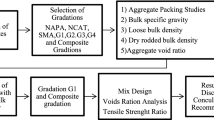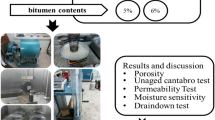Abstract
A comprehensive lithological and petrographic analysis of the aggregates gives information about the relationships between the aggregate properties and pavement performance. Although few studies have clearly established these relationships with various types of aggregates, they have not provided the effects of different types of carbonate aggregates. The purpose of this paper is to look at some aspects of the effects of different types of carbonate rocks on the performance of hot mix asphalt (HMA). Six types of aggregates that were evaluated in this study were collected from Central Alborz Zone (CAZ), one of the most important zones in Iran, and all of these were classified based on the petrographic study as carbonate rocks. This article has a deeper analysis of the rock material properties through a behavior analysis of asphalt mixtures subjected to boiling water, tensile strength ratio (TSR), semi-circular bending (SCB), and Cantabro tests. The most practical method for this purpose is to use microscopic thin sections of asphalt for evaluation of material properties on a small scale. Through an extensive laboratory program, the effects of aggregate properties on key mixture performance-based parameters such as adhesion, moisture susceptibility, fatigue, and durability are systematically summarized. The finding results show a classification for six different carbonate rocks based on their geological parameters. Also, a table is provided to aid in rock classification, indicating the most likely trend of each performance-based test result for carbonate rocks. Based on the Dunham classification for carbonate rocks, mud-supported materials have higher performance than grain-supported materials.





















Similar content being viewed by others
References
AASHTO T 283–14 (2018) Standard method of test for resistance of compacted asphalt mixtures to moisture-induced damage. American Association of State and Highway Transportation Officials
AASHTO TP 108–14 (2020) Describes the procedure for determining the percent abrasion loss of asphalt mixture specimens using the Los Angeles abrasion machine. American Association of State and Highway Transportation Officials
AASHTO TP 124–20 (2020) Provisional standard method of test for determining the fracture potential of asphalt mixtures using Semicircular Bend Geometry (SCB) at intermediate temperature. American Association of State and Highway Transportation Officials
Abo-Qudais AS, Al-Shweily HA (2007) Effect of aggregate properties on asphalt mixtures stripping and creep behavior. Constr Build Mater 21(9):1886–1898
Afaf AHM (2014) Effect of aggregate gradation and type on hot asphalt concrete mix properties. J Eng Sci Assiut Univ Fac Eng 42:567–574
Al-Qadi IL, Abauwad IM, Dhasmana H, Coenen AR (2014) Effects of various asphalt binder additives/modifiers on moisture-susceptible asphaltic mixtures. Illinois Center for Transportation
Al-Suhaibani AS (1995) Effect of aggregate properties on asphalt concrete mixes. JKAU: Eng. Sci 7:93–110
Anon (1979) Classification of rocks and soils for engineering geology mapping, part 1: rock and soil material. Bull Assoc Eng Geol 19:355–371
Assereto R (1966) Explanatory notes on the geological map of upper Djadjerud and Lar valleys (Central Alborz, Iran), Series G., publication no. 232. Institute of Geology of the University of Milan, Italy
ASTM C127–15 (2015) Standard test method for relative density (specific gravity) and absorption of coarse aggregate. ASTM International, West Conshohocken, PA
ASTM C128–15 (2015) Standard test method for relative density (specific gravity) and absorption of fine aggregate. ASTM International, West Conshohocken, PA
ASTM C131–20 (2020) Standard test method for resistance to degradation of small-size coarse aggregate by abrasion and impact in the Los Angeles machine. ASTM International, West Conshohocken, PA
ASTM D2938-95 (2002) Standard test method of unconfined compressive strength of intact rock core specimens. ASTM International
ASTM D113–17 (2017) standard test method for ductility of asphalt materials. ASTM International, West Conshohocken, PA
ASTM D1559–89 (1998) Test method for resistance of plastic flow of bituminous mixtures using marshall apparatus (Withdrawn 1998). ASTM International, PA
ASTM D1754–20 (2020) Standard test method for effects of heat and air on asphaltic materials (thin-film oven test). ASTM International, West Conshohocken, PA
ASTM D2042–15 (2015) Standard test method for solubility of asphalt materials in trichloroethylene. ASTM International, West Conshohocken, PA
ASTM D2171–18 (2018) Standard test method for viscosity of asphalts by vacuum capillary viscometer. ASTM International, West Conshohocken, PA
ASTM D36–14 (2020) Standard test method for softening point of bitumen (ring-and-ball apparatus). ASTM International, West Conshohocken, PA
ASTM D3628–15 (2021) Standard practice for selection and use of emulsified asphalts. ASTM International, West Conshohocken, PA
ASTM D5–20 (2020) Standard test method for penetration of bituminous materials. ASTM International, West Conshohocken, PA
ASTM D70–21 (2021) Standard test method for specific gravity and density of semi-solid asphalt binder (pycnometer method). ASTM International, West Conshohocken, PA
ASTM D92–18 (2018) standard test method for flash and fire points by Cleveland open cup tester. ASTM International, West Conshohocken, PA
Bagampadde U, Isacsson U, Kiggundu B (2005) Influence of aggregate chemical and mineralogical composition on stripping in bituminous mixtures. Int J Pavement Eng 6:229–239
Bagampadde U, Isacsson U, Kiggundu B (2006) Impact of bitumen and aggregate composition on stripping in bituminous mixtures. Mater Struct 39:303–315
Behiry EM (2015) Optimisation of hot mix asphalt performance based on aggregate selection. Int J Pavement Eng 17(10):924–940. https://doi.org/10.1080/10298436.2015.1043634
Bhasin A (2006) Development of methods to quantify bitumen-aggregate adhesion and loss of adhesion due to water. PhD thesis. Texas A&M University, College Station
Birgisson B, Roque R, Page GC (2003) Evaluation of water damage using hot mix asphalt fracture mechanics. J Assoc Asphalt Paving Technol 72:424–462
Brown R, Kandhal PS, Roberts FL, Kim RY, Lee DY, Kennedy TW (2009) Hot mix asphalt materials, mixture design, and construction, NAPA, Lanham, MD
BS 812–105.1 (1989) Testing aggregates. Methods for determination of particle shape. Flakiness index, BSI
BS 812–105.2 (1990) Testing aggregates. Methods for determination of particle shape. Elongation index of coarse aggregate, BSI
Caro S, Masad E, Bhasin A, Little DN (2008) Moisture susceptibility of asphalt mixtures, part 1: mechanisms. Int J Pavement Eng 9(2):81–98
Cong L, Peng J, Guo Z, Wang Q (2017) Evaluation of fatigue cracking in asphalt mixtures based on surface energy. J Mater Civ Eng 29(3):D4015003
Cox BC, Smith BT, Howard IL, James RS (2017) State of knowledge for Cantabro testing of dense graded asphalt. J Mater Civ Eng 29(10):04017174
Curtis CW, Ensley K, Epps J (1993) Fundamental properties of asphalt-aggregate interactions including adhesion and absorption. Strategic Highway Research Program (SHRP) Rep. No. SHRP-A-341, National Research Council, Washington, DC
D’Angelo J, Anderson RM (2003) Material production, mix design, and pavement design effects on moisture damage. The National Academies Press, Moisture Sensitivity of Asphalt Pavements
Deere DU, Miller R (1966) Engineering classification and index properties for intact rock: Technical Report on Air Force Weapons Lab. 65-116, New Mexico, No. AFWL-TR
Doyle JD, Howard IL (2011) Evaluation of the Cantabro durability test for dense graded asphalt. Proc., Geo-Frontiers 2011 (GSP 211), ASCE, Dallas, 4563–4572
Dunham RJ (1962) Classification of carbonate rocks according to depositional texture. Am Assoc Pet Geol1:108–121
Fan S, Wang H, Zhu H, Sun W (2018) Evaluation of self-healing performance of asphalt concrete for low-temperature fracture using semicircular bending test. J Mater Civ Eng 30(9)
Ferjani A, Carter A, Vaillancourt M, Dardeau A, Gandi A (2019) Effect of cement content on cracking resistance of full-depth reclamation materials using the semicircular bending test. Adv Civ Eng Mater 8(1):411–422
Georgiou P, Loizos A (2014) A laboratory compaction approach to characterize asphalt pavement surface friction performance. Wear 311(1–2):114–122. https://doi.org/10.1016/j.wear.2013.12.028
Ghorbani M (2013) The economic geology of Iran, mineral deposits and natural resources. Springer, Netherlands
IHAP (Iran Highway Asphaltic Pavements) (2010) Iran Management and Planning Organization, Code 234, Tehran, Iran, 2nd edition
ISRM (1981) Rock characterization testing and monitoring, ISRM suggested methods. Commission on testing methods. International Society for Rock Mechanic
Kamran F, Basavarajappa M, Bala N, Hashemian L (2021) Laboratory evaluation of stabilized base course using asphalt emulsion and asphaltenes derived from Alberta oil sands. Constr Build Mater 283:122735. https://doi.org/10.1016/j.conbuildmat.2021.122735
Kanitpong K, Bahia HU (2003) Role of adhesion and thin film tackiness of asphalt binders in moisture damage of HMA. Asphalt Paving Technol 72:502–528
Kavussi A, Naderi B (2020) Application of SCB test and surface free energy method in evaluating crack resistance of SBS modified asphalt mixes. J Civ Eng Infra 53(1):103–114. https://doi.org/10.22059/ceij.2019.276295.1555
Kavussi A, Qorbani M, Khodaii A, Haghshenas HF (2014) Moisture susceptibility of warm mix asphalt: a statistical analysis of the laboratory testing results. Constr Build Mater 52:511–517. https://doi.org/10.1016/j.conbuildmat.2013.10.073
Lee DY, Guinn JA, Khandhal PS, Dunning RL (1990) Absorption of asphalt into porous aggregates. Strategic Highway Research Program (SHRP) Rep. No. SHRP-A/UIR-90–009, National Research Council, Washington, DC
Ling C, Hanz A, Bahia H (2016) Measuring moisture susceptibility of cold mix asphalt with a modified boiling test based on digital imaging. Constr Build Mater 105:391–399. https://doi.org/10.1016/j.conbuildmat.2015.12.093
Liu HY, Jia YQ (2011) Study on the action mechanism of bitumen emulsion and aggregate. Trans Tech Publ, Adv. Mater. Res
Liu W, Yan K, Li QJ, Yang S (2021) Peridynamics-based simulation of semi-circular bending (SCB) testing. Constr Build Mater 268:121190. https://doi.org/10.1016/j.conbuildmat.2020.121190
Lue R, Lytton RL (2013) Selective absorption of asphalt binder by limestone aggregates in asphalt mixtures. J Mater Civ Eng 25(2):219–226
Maiah H, Al-Khateeb G (2012) Effect of basalt and limestone aggregate combinations on superpave aggregate properties. The 5th Jordanian International Civil Engineering Conference, Amman, Jordan
Ribeiro RC, Correia JCG, Seidl PR (2009) The influence of different minerals on the mechanical resistance of asphalt mixtures. J Petrol Sci Eng 65(3–4):171–174
Sadeghi E, Nikudel MR, Khamehchiyan M, Kavussi A (2022a) A comprehensive view on the compilation of an engineering geological map of carbonate rocks: a case study in the Central Alborz Zone, Iran. Q J Eng Geol Hydrogeol. https://doi.org/10.1144/qjegh2021-062
Sadeghi E, Nikudel MR, Khamehchiyan M, Kavussi A (2022b) Estimation of unconfined compressive strength (UCS) of carbonate rocks by index mechanical tests and specimen size properties: Central Alborz Zone of Iran. Rock Mech Rock Eng 55:125–145
Taherkhani H (2016) Investigation of asphalt concrete containing glass fibers and nanoclay. J Civ Eng Infra 49(1):45–58
Tan Y, Guo M (2013) Using surface free energy method to study the cohesion and adhesion of asphalt mastic. Constr Build Mater 47:254–260
Wang X, Ren J, Gu X, Li N, Tian Z, Chen H (2021) Investigation of the adhesive and cohesive properties of asphalt, mastic, and mortar in porous asphalt mixtures. Constr Build Mater 276:122255
Watson DE, Moore KA, Williams K, Cooley LA Jr (2003) Refinement of new-generation open-graded friction course mix design. Transp Res Rec 1832:78–85
Yan C, Zhang YU, Bahia H (2020) Comparison between SCB-IFIT, un-notched SCB-IFIT and IDEAL-CT for measuring cracking resistance of asphalt mixtures. Constr Build Mater 252:119060. https://doi.org/10.1016/j.conbuildmat.2020.119060
Zaumanis M, Poulikakos LD, Partl MN (2018) Performance-based design of asphalt mixtures and review of key parameters. Mater Des 141:185–201. https://doi.org/10.1016/J.MATDES.2017.12.035
Ziari H, Orouei M, Divandari H, Yousefi A (2021) Mechanical characterization of warm mix asphalt mixtures made with RAP and Para-fiber additive. Constr Build Mater 279:122456. https://doi.org/10.1016/j.conbuildmat.2021.122456
Acknowledgements
The authors would like to thank Tarbiat Modares University for providing engineering geology laboratory and Roads and Transport laboratory facilities.
Author information
Authors and Affiliations
Corresponding author
Ethics declarations
Conflict of interest
The authors declare no competing interests.
Rights and permissions
About this article
Cite this article
Sadeghi, E., Nikudel, M.R., Kavussi, A. et al. Evaluation of different types of carbonate aggregate performance in asphalt mixtures. Bull Eng Geol Environ 81, 329 (2022). https://doi.org/10.1007/s10064-022-02815-8
Received:
Accepted:
Published:
DOI: https://doi.org/10.1007/s10064-022-02815-8




